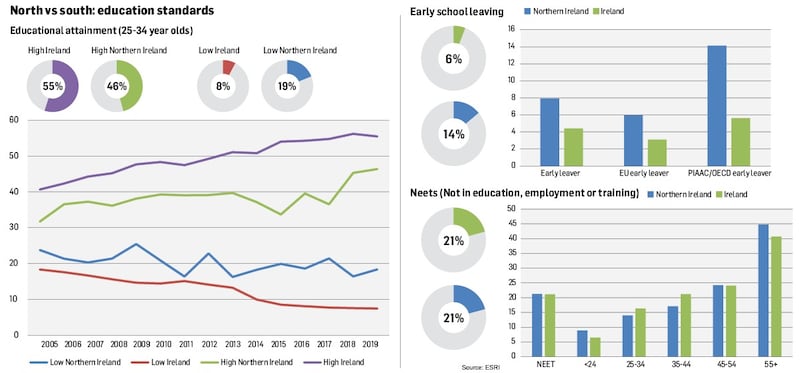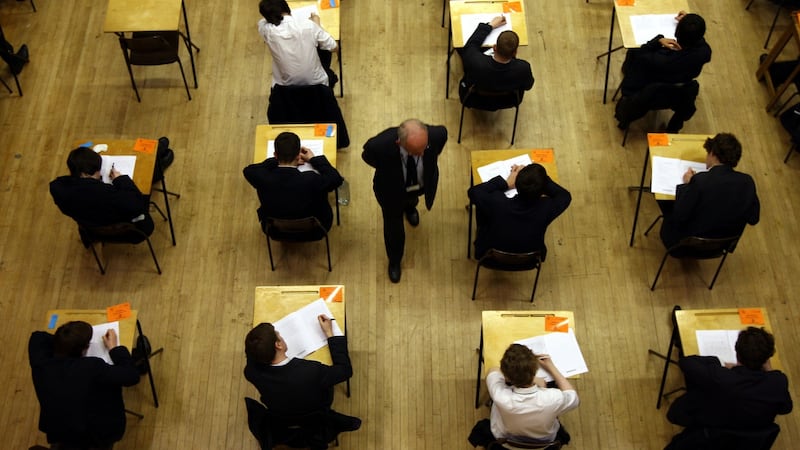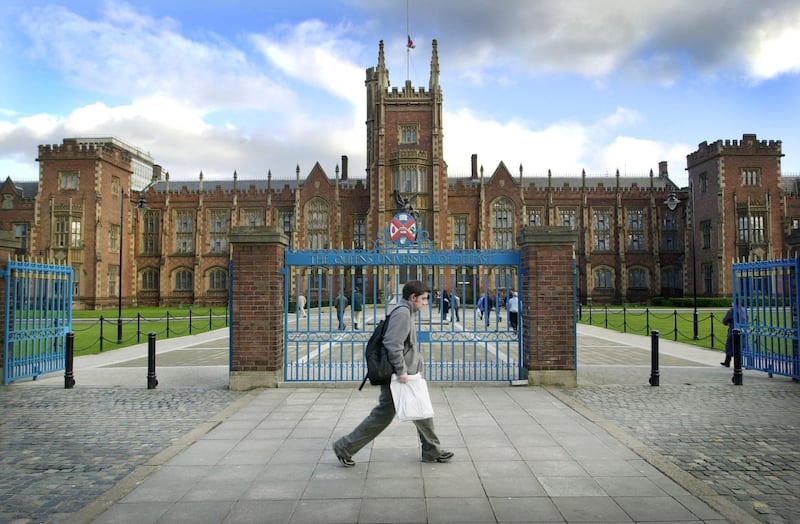The hum of debate over the prospect of a united Ireland is growing louder – but when it comes to the question of how education systems on both sides of the Border might align, there has been relative silence.
A recent study by the Economic and Social Research Institute (ESRI) is the first to systematically compare systems and outcomes in both jurisdictions from primary education all the way through to third level. It explores a range of issues including educational attainment, inequalities, skills development and labour market outcomes on either side of the Border.
Despite their proximity, researchers found plenty of ignorance of each others’ education systems.
“I would say the degree of mutual understanding and knowledge of each other’s systems and policies... is pretty low, certainly on the ground,” one education stakeholder told researchers. “I would say most people up here [in Northern Ireland] wouldn’t have a clue and vice versa,” said another.
READ MORE
So, what are the strengths and weaknesses of both jurisdictions? What are the skill levels among the two populations? What can each system learn from the other? How far apart are they? And how much work would be needed for them to operate under a whole island system?
Primary education
It might be hard to believe, but the island Ireland shared the same school system just over a century ago. The “Stanley letter” of 1831 – from the chief secretary of the British government to the Duke of Leinster – is widely considered as the foundation for the national school in Ireland. The vision was that national schools would be non-denominational and religious instruction should be separate. Within a few decades, however, the power of the churches ensured the vision was never realised – and national schools became denominational in character.
At present, about 93 per cent of schools are denominational in Northern Ireland; in the Republic, about 93 per cent at primary are denominational while just over 50 per cent are denominational at post-primary.
Both system diverged considerably over the years in approaches to tackling disadvantage, special education and academic screening.
[ The Irish Times view on schools in Northern Ireland: segregated classroomsOpens in new window ]
However, North and South perform well in international comparisons at primary. The two areas have broadly comparable patterns of skill development and similar patterns are evident by social background, indicating comparable levels of inequality in skill development.
In both jurisdictions, the highest skill levels are found among those whose mothers are better educated (a degree or higher qualification) and the lowest levels found among those whose mothers have lower secondary education or less.
The Republic and Northern Ireland also emerge as high-performing countries in reading literacy and do relatively well in maths and science literacy among 10-year-olds. Average maths scores are significantly higher in Northern Ireland, while average science scores are significantly higher in the Republic.
The spread of scores in reading and maths – that is, the difference between higher and lower attainers – is wider in Northern Ireland. This, researchers suggest, may be related to much greater use of ability grouping for reading in Northern Ireland.
The two systems differ in their approach to targeting educational disadvantage, though both focus on the provision of additional resources for schools serving socio-economically disadvantaged populations.
The Deis programme in the South is spoken of favourably on both sides of the Border, though previous research has highlighted the absence of supports for disadvantaged children and young people attending non-Deis schools in the Republic.

Deis was once seen as labelling schools, now it is a badge of honour. Brian Barron, principal of Portlaw National School in Co Waterford, which recently received Deis status, says the school now gets additional teachers and smaller classes.
“We also have additional hours for special education teachers. This allows us to run programmes such as social skills programmes in whole classroom settings because we can have two or three adults supporting the group.”
In Northern Ireland, additional resources for schools are not seen as being targeted in the same way, with a lack of connection between resourcing and specific supports or activities.
Secondary education
If outcomes are broadly similar at primary level on the island of Ireland, they begin to diverge at second level. Early school leaving is two to three times higher in Northern Ireland compared to the Republic – and this gap has widened over the past decade or more.
The proportion of 16-24-year-olds who left school with, at most, a lower secondary qualification is 14 per cent in Northern Ireland compared to 6 per cent in the Republic. Researchers say this is concerning as early school leavers are more likely to be non-employed or work in low-wage and potentially insecure jobs later in life.
[ CAO 2022: Six takeaways from this year’s college offersOpens in new window ]
In addition, students from disadvantaged backgrounds are more likely to be early school leavers in Northern Ireland than in the Republic.
Again, researchers suggest that a contributory factor may be that the Deis programme in the South is retaining students in education, along with the use of academic screening in the North.

As the ERSI study highlights, children are routinely organised according to ability in the North while more “academic” children attend one of 63 grammar schools and the remaining children attend secondary schools.
“A lot of parents see it as a desirable post-primary option for their children,” a Belfast-based teacher says. “The grammar/secondary school system in schools in the North in not going to change in the near future, unless all schools move at the same time to an integrated system for education.”
However, being channelled into non-grammar schools leads to low educational expectations, particularly for boys from disadvantaged backgrounds. This lack of aspiration among boys from deprived areas was reiterated as an issue by stakeholders in the ESRI’s research.
[ Explaining the progression charts of Irish secondary schoolsOpens in new window ]
The lack of screening on entry to post-primary, however, is noted as positive feature of the Republic’s education system when it comes to reducing inequalities and supporting those suffering from economic disadvantage.
Academic screening is no longer permitted under school admissions legislation in the Republic (although some say fee-charging schools are in some ways our own version of grammar schools).
There are also other key differences across both systems at second level, teachers say, such as the length of school holidays; the absence of compulsory subjects in the North; approaches to languages; end-of-school assessment and the powerful role of teachers’ unions in the Republic.
Further and higher education
The proportion of graduates is the same in both jurisdictions. However, Northern Ireland has only a small proportion who complete a further education-style qualification compared to the Republic. Ten per cent of the population in the North has this level of qualification compared to 30 per cent in the South.
Seamus McGuinness, ESRI research professor and co-author of the report, says there are also far fewer options for students who might not follow the university route in Northern Ireland.
“Contrastingly, the PLC (Post Leaving Cert) route in the South is relatively easy to move into,” he says. “It is particularly effective for people from a working-class background. The system in the North does not facilitate intergenerational mobility in the same way.”
This lack of equity and opportunity, McGuinness argues, has much to do with academic screening in the North. To prepare for these, parents provide private tuition for their children, at £20 to £30 an hour.
Overall, there are marked differences in educational attainment between the Republic and Northern Ireland among 25-34 year olds.
The level of “low education” was 7 per in the South in contrast to 18 per cent in the North, while the proportion with “high education” was about 56 per cent in the South compared to 47 per in the North.

So, what kind of questions do all of these findings create for those in charge of policymaking?
For Dr Anne Devlin, another co-author of the ERSI report says: “Greater co-operation across the island would be beneficial in a range of areas but particularly in tackling educational disadvantage and promoting the inclusion of students with special educational needs.”
David Rice, journalist and author, currently working on a book on the topic, warns against a united Ireland before the introduction of integrated education in Northern Ireland.
“Since children are educated at separate denominational schools they simply never see one another. The result is stereotyping and otherness towards the opposite side. So, a first step towards breaking down barriers would surely be integrated education.”

















